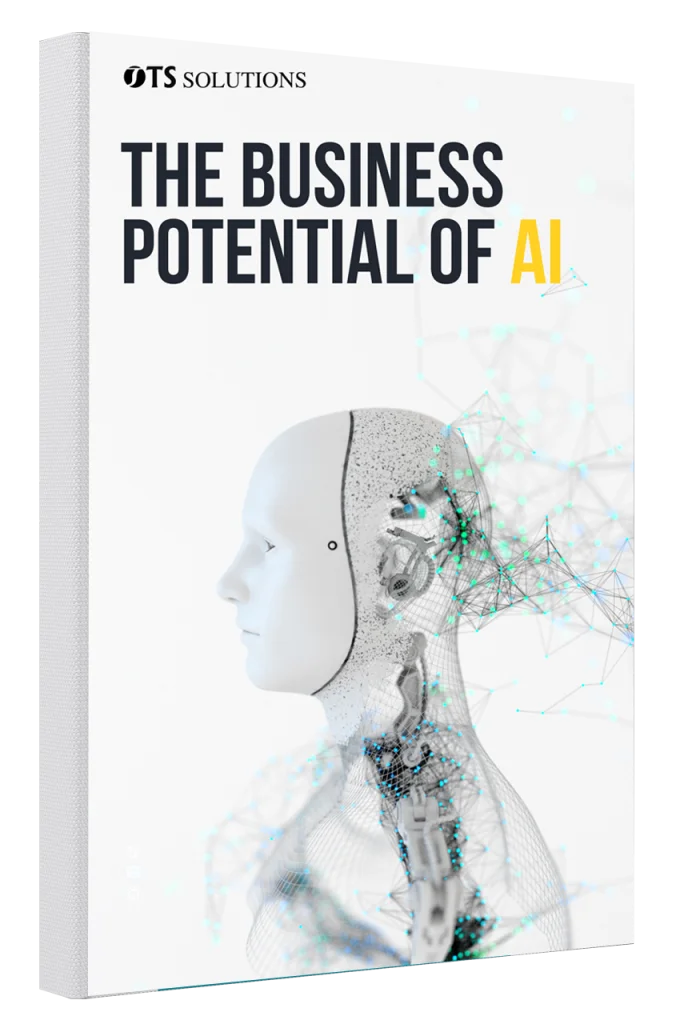How Digital Transformation Can Help Your Business Grow?
You have surely heard the buzz about digital transformation, but what is it? You are not alone if you are a bit curious about this word. Digital Transformation is a broad concept. Let us try to understand digital transformation in detail.
In this article, we discuss the concept in more detail and unpack what it involves. By the end, you should have a comprehensive understanding of digital transformation the technology it requires to its potential impacts on businesses.
Overview of Digital Transformation
Digital transformation means the operational, cultural, and organizational changes within an organization’s ecosystem with the help of modern technologies such as cloud computing, the Internet of Things, artificial intelligence, machine learning, mobile apps, etc. With the implementation of these technologies, you can achieve a more agile, customer-centric streamlined, and efficient business.
The process of digital transformation can involve everything from adopting cloud-based services and applications to leveraging AI-driven technologies to enhance customer experiences and user interfaces. It also involves exploring new channels to reach customers, such as social media strategies or multi-channel marketing campaigns. It all comes down to finding the right mix of technologies that can help you become a more efficient and profitable organization.
Importance of Digital Transformation for Business Growth
1. Improved data gathering:
Most businesses gather data from customers. The company uses the help of this data to move the company ahead as this data will help to make your products more productive for your customers.
2. Keeping ahead of the competition:
Companies may now take the lead because of changes in technology and capacity but you may not achieve this without digital transformation. By involving digital transformation, you will always be ahead in front of your rivals.
3. Make better decisions:
Companies can benefit from big data by putting analytics and data at the core of their digital transformation if the business does not. Businesses today have access to larger volumes of data than ever before because of the Internet of Things, and it is one of the major technologies in digital transformation. With the right mix of analytical tools, this data may be translated into crucial business insights, enabling you to make choices more quickly and more effectively.
4. Long-term gains:
The benefits of digital transformation will last for a long time. Recent estimates predict that by 2023, global spending on the technology that supports digital transformation will amount to about $2.3 trillion. Digital transformation is essential if your business hopes to benefit overall by implementing digital technologies.
Challenges to Digital Transformation
1. Complicated technology and Software:
Innovative and modern technologies can be complicated for some companies. This is a significant barrier for businesses going through a digital transformation, both in terms of digital transformation and data integration as well as end-user experience. While a transformation project is in its early phases, developers should consider this and look for the most user-friendly integrated systems.
2. Lack of transformation strategy:
Before planning for your digital transformation strategy, you need to ask questions such as Are you prepared to transition your current systems into new ones in a proper manner? Is this crucial? All these queries need to be addressed before a digital transformation strategy is put into place. Without a set strategy, a transformation project cannot be successful. Recognize the parts of your business that need to be upgraded and where improvements may be made, then start there.
3. Technical resource shortage:
Businesses currently struggle with a lack of additional resources necessary for the adoption of digital initiatives in addition to talent scarcity. The lack of sufficient resources prevents timely allocation to the appropriate activities.
4. Decision-making in silos:
Silos within organizations hinder digital transformation. They are a barrier in every stage of transformation, from developing strategies to putting them into practice. While each team or department concentrates on resolving its issues and accomplishing its objectives. Silos or different departments may result in a disjointed decision. This can be one of the biggest challenges in the adoption of digital transformation.
Case Studies and Examples of Digital Transformation
When it comes to digital transformation, the key is to understand what it looks like, both in theory and practice. In this section, we will look at a few examples of successful digital transformation initiatives.
1. Boeing
An example of a successful digital transformation is Boeing’s initiative to use advanced analytics and machine learning technology to improve its supply chain. By collecting data from its global network of suppliers, Boeing was able to accurately predict when parts and components would be needed, streamlining production time while reducing costs.
2. Bank of America
Another successful digital transformation was implemented by Bank of America. To increase customer engagement and reduce operational costs, Bank of America began offering mobile banking via its app. This allowed customers to quickly check their balances, pay bills, and transfer money without having to make a trip to the bank branch.
3. Walmart:
One more successful digital transformation is Walmart’s reliance on analytics and AI (Artificial Intelligence) technology for its supply chain management process. By using real-time data from vendors and customers, Walmart improved the accuracy and efficiency of its supply chain operations.
As you can see from these examples, digital transformation can have tangible results for organizations. With the right strategy in place, your organization can reap similar benefits for your digital transformation efforts.
Digital Transformation Technologies
1. Cloud Computing:
Each organizer should embrace the digital transformation process when necessary to replace their outdated IT infrastructure with a new one to remain competitive and add value to the business. Beyond implementing cloud solutions, a firm should incorporate innovative technologies like artificial intelligence, machine learning, big data analytics, and the Internet of Things (IoT) that speed up, automate, and optimize commercial operations. Since these technologies demand significant computational resources and storage space, cloud computing offers a way to integrate them.
2. Internet of Things:
IoT is an interconnected network of devices that can collect and transmit data from physical objects to digital networks this technology allows businesses to collect real-time data from connected devices so that they can gain insights into how customers interact with their products or services.
3. Artificial Intelligence:
AI is a computer science field that focuses on creating intelligent machines that can think and act like humans. AI can be used to automate manual tasks and reduce the amount of effort required for tasks such as data analysis. It also has potential for other applications such as customer support and fraud detection Etc.
4. Blockchain technology:
Blockchain technology is an immutable digital Ledger system, that can securely store data without the need of centralised storage or control its decentralised nature makes it ideal for building trust between parties and it also allows transactions to be transparently tracked and verified with accuracy. Each of these technologies offers distinct benefits when it comes to digital transformation, and they can be used together with one another to unlock even greater potential outcomes.
6 Core Components of Digital Transformation?
1. Innovation:
Digital transformation as the word says helps you to transform your businesses digitally with the help of the latest technologies. As business owners, we need to stay ahead of our competitors to serve our customers better. AT OTS Solutions, we are continually integrating modern technologies, creating new products and solutions, and helping others utilize digital transformation technologies to stay ahead. We are also helping our customers on their path to technological modernization and digital transformation by staying at the forefront.
2. Collaboration:
Digital transformation technologies bring you an opportunity to collaborate with modern technologies to optimize your work. With the help of technologies such as cloud computing, it is now possible to receive instant feedback and responses from clients. OTS Solutions develops solutions and businesses with the best collaborative measures for its clients.
3. Experience:
AT OTS Solutions, we recognize how digital transformation can impact your businesses. Our goal is to work with you to create a system that can be used to fulfill your business needs. We help you with business processes and all the essential processes. In this way, we can help you to continue highlighting your expertise and differentiating your products in the future.
4. Infrastructure Modernization:
Infrastructure modernization brings you opportunities to innovate. AT OTS Solutions, we can help our clients to migrate their legacy systems into modern technologies. In our research, we found that platform-as-a-service significantly minimizes the workload that was there in on-premises systems by providing the capability and security you need.
6. Process and Practices:
Organizations must understand how digital solutions can be applied to current processes and practices to optimize them for better collaboration, greater productivity, or improved customer experience. This requires a deep dive into existing processes and practices and an analysis of what can be automated for greater efficiency.
5. Culture and People:
Organizations must have a culture of experimentation and innovation for digital transformation efforts to succeed. People should be encouraged to think creatively technology about how existing technologies can be applied or innovative technologies developed to advance their business goals. This type of culture encourages an environment where employees are empowered with the necessary tools, resources, and freedom they need to effectively implement their ideas in the workplace.
6. Digital Transformation Framework:
Digital transformation entails a change in business culture. A digital transformation framework is a set of guidelines that an organization sets to direct it through the change. The digital transformation framework gives you a step-by-step guide for handling change. It outlines a plan for attaining the objectives throughout an entire organization.
Your digital transformation strategy framework should be data-driven and help in fast decision-making using predictive models. The inputs in digital transformation are dynamic. This means your system must open to change when the data changes. This framework also helps you in deciding the best operational model for your business. A framework for digital transformation is a technique that organizations frequently use to analyze a business’s growth. In contrast, traditional management consulting frameworks are intended to be subjective while these modern digital transformations are to be data-driven.
3 Main Areas of Digital Transformation
1. Process Transformation
The process transformation in digital transformation is a long-term change management process that involves transforming, optimizing, and controlling the cycle from developing the strategy and reevaluating methods of operation to assisting with implementation and tracking results.
2. Business Model Transformation
A business model is a strategic plan for an organization to generate income via the provision of goods or services that provide value. A business model incorporates prospective interaction tactics and practices, target audiences for whom the products or services are suitable, and estimated costs.
3. Domain Transformation
Domain transformation happens when a business can effectively move into a different industry. One of the biggest examples of domain transformation is Amazon. For instance, Amazon added Amazon Prime, a streaming service, Amazon web services (AWS), cloud service, and many other services.
Future of Digital Transformation:
1. Opportunities on the internet of things:
There will be 22 billion connected devices by 2025. This growth presents a huge opportunity for the manufacturing sector, boosting production flows through improved visibility of business operations, as well as the manufacturing supply chain, and outsourced operations. The growth is being driven in large part by lower costs of sensor technology.
2. Technologies to be implemented.
One of the most important tasks when creating a digital transformation strategy is figuring out what technologies are appropriate for your company. Your organization will need to invest a significant amount of money in technology implementation. It must thus be done properly to eliminate the requirement for further funds.
Any good digital transformation strategy will always offer a few options together with their associated costs to help the decision-maker reach the optimal conclusion. You must choose the most appropriate technology, whether you are working to modernize legacy systems, and applications, or develop whole new digital systems.
3. Process Optimization
The plan must guarantee business process optimization while achieving the objectives established for both the internal team and the target audience. The Digital Transformation strategy must include a very connected business process to maximize output. You must effectively utilize your collected data in addition to optimizing company processes.
To succeed, businesses and societies must integrate technology into every feature or operation, including daily activities. Increased domains are becoming clear to enhanced digitalization. However, with the introduction of remote working, people have begun using different channels for objectives. Sales and marketing make use of emerging technologies and applications to benefit from the latest trends.
The fact that most organizations do not update and prepare their roadmaps and organizational structures for Digital Transformation, along with investment in Digital Transformation and ecosystems. At least 30% of organizations have already accelerated any type of innovation to protect their company’s future.
The goal of a Digital Transformation strategy is to address the prerequisites. You can make sure that your business transitions to the digital age as smoothly as possible by developing an efficient, transparent, and strong Digital Transformation strategy. A Digital Transformation plan is like a tailored road map for making significant changes to your company’s business processes. It takes a significant amount to make sure that your team is being led by highly skilled and knowledgeable technical leaders.
What is a Digital Transformation Roadmap?
A roadmap for Digital Transformation is a strategy that takes your business from the current stage of your system to the new digital processes. Your plan for Digital Transformation aids in defining and managing projects. To ensure a successful transformation, it gives structure to the transition from one tool to the next, incorporating everything from technology, people, and processes.
Let us discuss the roadmap in detail!
1. Identify the Current Stage:
Various frameworks such as SWOT and STEEP analysis help you to understand the current state of your business. SWOT analysis means. Strengths, Weaknesses, Opportunities, and Threats. The company’s digital capabilities become considerably evident after the SWOT analysis is finished.
Secondly, you can perform STEEP analysis to measure political, social, economic, environmental, and technological variables. It goes beyond SWOT analysis and provides a comprehensive gap in current digital capabilities.
2. Goals and Objectives:
To guide the transformation process, establish goals and objectives that are precise, practical, and measurable. Establishing goals can help your business position itself for success and get meaningful ROI (Return on Investment) more quickly.
The transformation can be made more achievable for your team by segmenting your roadmap. Every stage gives you a more manageable task to do as well as a clear chance to recognize and evaluate your strategy.
3. Invest in Agile Project Management:
Agile project management is centered on establishing a cooperative setting for putting the latest ideas into practice, testing them, and adapting to change. While having a predetermined strategy is crucial, agile project management offers chances to regularly review the plan and make changes in response to the demands or queries of the team.
Agile project management divides the project into sprints, followed by feedback, which assures a high rate of success for transformation activities. You would gather input from your team following each modification to determine what is working and what is not. So, that you can improve the overall implementation process.
It is not difficult to develop a good Digital Transformation strategy if your company is equipped with experienced employees. You can adjust to change and keep up with changing expectations if you have the necessary assistance and knowledge. If you are all set to begin the procedure for your company, then we can assist you. You can trust OTS Solutions as your Digital transformation partner. Here we have skilled business analysts, scrum masters, quality assurance engineers, and developers as well as all the other roles required in your business transition.
Why is Technology Important to Digital Transformation?
Are you looking to unlock the potential of digital transformation in your business? Technology is key. With technology, you can create more efficient processes, engage with customers in new ways, and get up to speed with the competition.
Let us look at a few specific examples of how technology can help you achieve digital transformation.
1. Automation: Automation is a wonderful way of streamlining processes, eliminating manual tasks, and freeing up your staff’s time for other important projects.
2. Data Analysis: By collecting data from various sources and analyzing it with powerful tools, you can gain valuable insights into customer behavior, business trends, and overall performance.
3. AI-enabled applications: AI-enabled applications can help take customer service to the next level by providing personalized recommendations and creating automated responses for commonly asked questions.
Conclusion:
Digital Transformation is more than just technology. It is about leveraging the power of technology to create meaningful experiences for more customers. It is about being able to adapt quickly to the changes in the market.
We at OTS Solutions understand that digital transformation is essential for staying competitive in an ever-changing digital world. You can contact us if you want to transform your software digitally with modern technologies.
Want to know more about our digital transformation services?
Frequently asked questions:
What are the stages of Digital Transformation?
There are four stages of digital transformation. These are:
- Planning.
- Implementation.
- Acceleration.
- Measurement.
What industry needs Digital Transformation?
Several types of industries that use digital transformation are:
- Healthcare industry
- Automotive industry
- Legal
- Education
- Retail
- Fintech
- Tourism
What is the impact of Digital Transformation on business?
Digital transformation helps in improving the efficiency of their operations by enabling large-scale automation. It also helps reduce operational costs and human errors.
How does digitalization contribute to company performance?
The advantages of digitization that contribute to system performance are:
- Improved decision-making,
- improved information security
- Increase productivity.
- Increase customer experience.
- Improved information security
- Lower operational costs
How do augmented, virtual, and mixed reality contribute to digital transformation?
Virtual, augmented, and mixed reality are three emerging technologies that have revolutionized the digital landscape. These technologies work by creating a simulated environment where users can interact in a virtual world.
How do enterprise applications fit into the digital transformation process of a company?
Enterprise applications play a critical role in the process by providing the necessary tools and functionality for businesses to streamline their processes, automate tasks, and enhance their decision-making capabilities.
Related Blogs:
- How does Digital Technology help build the Next Generation of Dental Practices?
- App Modernization in the Digital Age: The Role of AI and ML in Application Modernization
- App Modernization: How to Keep Your Business Competitive in the Digital Age?
- How Industry 4.0 Changes Predictive Maintenance From Mobile Apps And What It Means For The Future?
- Digital Transformation: A Comprehensive Guide for Any Business








